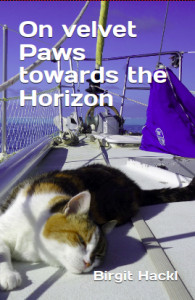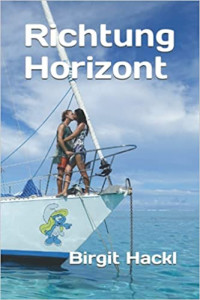I got back on Friday after an exhausting journey (31 hours from door to door…) enjoyed quite a jet-lag in the bouncy, uncomfy Marina Taina (seasick medicine in the anchorage, hurray!) and on Sunday we moved on to the much calmer and nicer anchorage off Arue. From there we ran some errands on Monday and today we left busy Papeete behind us, to sail the 10 mile hop over to beautiful Moorea. The French weather report talked of 7 to 10 knots with ‘mer belle’ (‘beautiful’, meaning calm seas), so we expected some lazy motorsailing. What we got instead were 25 knots close-hauled and to call that sea beautiful you had to seriously be into big waves and whitecaps… At least it was a quick sail, but when we tried to find an anchoring spot off Vaiare (we’d never been to the eastern side of Moorea before) we had a hard time finding something between 30 m (the lagoon) and 2 metres (the reef shelf, but we draw a bit more than two…). Now we’re anchored a bit precariously near the reef, so we’ll search for a better spot tomorrow.
2015
24
Jun
2015
11
Jun
Anchor windlass overhaul
When we were about to lift the anchor to leave Raivavae two weeks ago, our anchor winch stopped working and I had to crank up the chain manually. But with Tahiti as the next stop, the moment our windlass had decided to quit was actually not so bad.
With the help of a good friend here in the anchorage off Marina Taina I took the winch completely apart. The reduction gear had almost no oil left and two of its bearings had rusty balls and didn’t rotate very well. The oil seals were apparently worn out by the rough, rusty shaft. Fortunately there is a well-stocked shop for bearings and oil seals in Papeete (‘Evo’ in Fare Ute). We’ve got the shaft ‘cleaned’ and the new bearings pressed on at a machine shop in Papeete. An even more severe problem was the winch motor as its rotor spun so eccentrically that it had scratched the stator. So also the motor’s got a new bearing and a new bushing (which I made myself from a bronze water-pipe fitting). Having the motor already apart, I sanded the brushes and the commutator.
Now everything is assembled with self-cut gaskets and our 30-year-old windlass (it’s a 1kW Muir Cougar) is running smoothly again like a new one. Total cost of overhaul: EUR 200.
2015
09
Jun
Snotty Pitufina
I had barely touched European ground when I met the fate of all happy, innocent, tropical islanders when they are exposed to nasty civilised viruses–I fell ill. At least I got away with a sore throat and a snotty nose and I hope to recover soon (unlike so many fellow islanders in the past…).
2015
05
Jun
Visit to Austria
After almost 4 years of boat life I flew to Austria yesterday morning local time Tahiti, so evening UTC or was it the day before yesterday(?)–the time zones got me all confused, at least I didn’t have to change the time on the watch thanks to 12 hours time difference ![]() Anyway, it took us 2 years to sail to French Polynesia and only 26 hours to fly back (31 from door to door) and my bio-rythm still seems to be lagging somewhere behind maybe Mid-Atlantic…
Anyway, it took us 2 years to sail to French Polynesia and only 26 hours to fly back (31 from door to door) and my bio-rythm still seems to be lagging somewhere behind maybe Mid-Atlantic…
I’ll spend two weeks in Austria and it seems I’ve chosen just the right time as it’s almost tropically warm and sunny this week ![]()
2015
30
May
Pitufa in Tahiti and the Societies
After doing some maintenance on Pitufa in Tahiti we’ll head to the Society Islands to explore Huahine and Maupiti that didn’t fit into our schedule last year and maybe revisit Moorea, Raiatea and Tahaa.
2015
30
May
Rock and Roll
After spending a year in quiet, calm places French Polynesia’s capital Papeete on Tahiti feels a bit overwhelming. About 250 boats sway on moorings or anchor off Marina Taina and they all roll and pitch like crazy whenever high swell comes up from the south and huge surf breaks over the unfortunately rather narrow fringing reef that protects the anchorage insufficiently. Two days ago it got so bad that we moved our matresses to the floor to get at least some sleep. Marina Taina’s overfilled dinghy dock’s a tough place for a small dinghy like ours and the location far outside Papeete means that we spend hours eating dirt on the dusty, congested roads waiting for buses and hitching rides while doing the usual hardware-store/chandlery ralley.
The positive side of being here is that we meet old friends again and that the huge supermarket Carrefour is within walking distance, so we can manoeuvre cartloads of provisioning over the bumpy sidewalk right to the dinghy dock.
Christian will stay here while I spend two weeks in Austria and after that we’ll try to get away from noisy, dirty Papeete as quickly as possible again.
2015
27
May
Back in Tahiti
Today we reached Tahiti after a really quick sail, in fact we almost had to slow down towards the end, because according to smurf rules only passages over 3 days deserve a bottle of sparkling wine and tapas ![]()
2015
26
May
Mahi Mahi
After an extended period of time without luck fishing, we caught a Mahi Mahi (Dorade) today. 105 miles to go!
2015
25
May
Warmer again
We’re rushung north and it’s getting warmer with every mile ![]()
2015
23
May
Sailing to Tahiti
Finally the weather seems to have settled again, the weather forecast predicts stable wind from the southeast so we’ll head out towards Tahiti in a few hours. It’s still cold and rainy here, but we hope it’ll get warmer with every mile we sail north!
2015
21
May
Cruising Info on Raivavae
As we hardly found cruising info on Raivavae, we’ve summarized our experiences in a small guide.
2015
17
May
Preparing for strong winds
The weather forecasts show quite an impressive low coming towards us tomorrow. As the forecast predicts sustained wind around 30 knots from the northwest and much higher gusts we’ve moved to the southern coast of the island, have brought out two anchors, tied the dinghy down on deck, removed the rain collecting canvas to reduce windage, etc.
It looks like we’ll be able to leave for Tahiti next week.
2015
17
May
Photos of Raivavae

Raivavae, Iles Australes
We visited Raivavae in May 2015 during the southern autumn. It was hard to find a weather window to get there and even more so to leave again due to weather quirks (a highly active South-Pacific Convergence Zone led to many lows). Here are some impressions of the few sunny days.
(50 photos)
2015
14
May
Motu Vaiamanu
Yesterday we used the calm and sunny weather to explore a bit more of the southern, shallow lagoon with its numerous coral heads. We first navigated to a natural opening in the fringing reef on the southern coast of Raivavae to have a GPS track to this protected spot on cloudy days. Then we proceded carefully to the big motu Vaiamanu on the southeastern barrier reef. It’s the only ‘public’ motu, all the others are private and we were suprised to hear that even local families aren’t allowed to visit them without the owner’s permission…
Anyway, we found a nice anchoring spot in between the bommies and took the dinghy over to the pretty motu with its endless white sand beach and diverse vegation mix of endemic shrubs, palm trees and introduced pine trees. There’s a huge, mint-coloured shallow area north of Vaiamanu with tiny motus fringing it, that’s why the French also call it ‘motu piscine’ (swimming pool). We were a bit disappointed though, that we hardly saw any birds or fish, not even the usually omnipresent reef sharks came by. We don’t really have an explanation for this lack of wildlife as only a few hundred people live on Raivavae and they don’t seem to take much interest in the lagoon and motus, but maybe they overfished/harvested too many eggs/hunted too many birds in the past.
2015
13
May
Mount Hiro
We’ve been waiting for wind to move on for more than a week now. First we had to sit out the passing lows and now there is a westerly breeze (for several days–that’s very unusual), so we can’t head west to Tubuai and there’s also not enough wind to take us up to Tahiti. Making the best out of the situation, we navigated Pitufa through the narrow lagoon along the northern coast and around the eastern cape where we anchored next to the pretty, rocky islet Hotuatua yesterday afternoon.
This morning we started out early to hike up the ridge of Mt. Hiro. We had picked a perfectly clear and sunny day for this hike and the views after the strenuous and steep ascent were simply breath taking.




